|
December 6, 2014
Goals
Short,
one-day, follow-up visit regarding chimpanzees and
elephants, as well as answering further questions of
staff regarding basic husbandry, enrichment, training,
reproduction, etc.
Chimpanzees
|
Mingming
F; 15 years old |
Laosan
(No.3) M; 6 years old |
Laowu
(No.5) M; 5 years old |
|
Laoda
(No.1) F; 9 years old |
Laosi
(No. 4) F; 6 years old |
Laoliu(No.6)
F; 5 years old |
|
Laoer
(No.2) M; 7 years old |
The
Hangzhou Zoo’s chimpanzees were found separated into
two groups, because one of the adult females, Mingming,
kept biting the younger animals. The groups seemed to be
doing well enough being housed next to each other and
could interact through the mesh.
The
zoo debated over which female they should send away for
cooperative breeding. Mingming, age 15, was chosen.
Laoda, although nicer to the younger chimpanzees, is
only 9 years old and considered being
too young.
Suggestions:
For the sake of the chimpanzees, especially the young
ones, it would be beneficial if the groups were put back
together in the absence of Mingming. If they are kept in
two groups, one group will be without a more mature
female. Although Laoda is not yet an adult (body and
mind), she is considerably older than most of the group
members and could provide some guidance for others.
Please review life stages and age related information as
per Center for Great Apes.
|
Infant:
|
Birth
– 5 years (nursed and carried by mother)
|
|
Juvenile:
|
5
– 8 years (still with mother but independent of
her for transport and milk)
|
|
Early
Adolescence:
|
Female:
8 – 10 years Male: 8 – 12 years
|
|
Late
Adolescence:
|
Female:
11 – 14 years Male: 13 – 15 years
|
|
Maturity:
|
16
– 33 years
|
|
Old
Age:
|
33
years – death
|
Center for Great Apes-
Treatment
of Apes
|
|
|
“Young
females learn to be mothers by watching their
mothers and helping with younger siblings. Young
males follow around after adult males, spending
less and less time with their mothers as they grow
older. At 13 to 15 years of age, chimpanzees spend
most of their time with adult males and females in
estrus. For females, late adolescence begins with
the onset of estrus cycles and adolescent
sterility and ends with the ability to reproduce.
Some females transfer to another community for a
brief period, and reproduce with males in that
community. Chimpanzees are mature at 16 to 20
years of age; old age begins at 33 years in the
wild. Wild chimpanzees may live to be 40 or 50
years old or more.” The oldest chimpanzees in
captivity were Cheetah, 76. Little Mama, 74 and
Gregoire, 66.
|
It
would be beneficial for staff to understand the
different aggression levels of chimpanzees and at what
point animals need to be separated. Chimpanzees fight
all the time. Chasing, hitting, pushing, pulling,
stomping on each other’s backs and even small biting
are considered “every day conversations.”
It
also needs to be understood that displaying is a
natural, normal behavior for male chimpanzees at any age
and males should not be separated from their group
members due to carrying out these behaviors.
“Displays:
It is important to provide opportunities for chimpanzees
to move, hit on, shake or throw objects in their
environment as part of their species-appropriate
displays. Care should be taken that these objects are
adequately fixed or that they are not able to cause
damage to the enclosure, other chimpanzees or to human
staff or visiting public.” Association of Zoos and
Aquariums (AZA) Chimpanzee Care Manual, 2010
Free
Chimpanzee Enrichment PowerPoint was given.
Diet
information was sent by follow-up email on January 12,
2015.
The
zoo’s chimpanzees are in good hands, with a dedicated
staff that is really trying to improve.
The
zoo also installed watering systems for the chimpanzees
in order for them to have fresh drinking water at all
times.
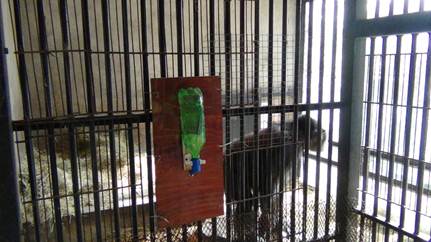
General
proposition
Several
meetings were held in small groups with staff depending
on specific interest (chimpanzee, elephant and
carnivore) about substrate use and general animal
keeping questions such as diet, temperature, etc. Around
164 husbandry manuals, SSP manuals, studbook
information, books in downloaded formats, Association of Zoos and Aquariums
(AZA)
and
African Association of Zoos and Aquaria
(PAAZAB)
accreditation standards and articles, power point
presentations, etc. were provided.
Elephants
Zoo
started to make some changes. Two tires were hung and a
small pile of sand was brought in.
Suggestions:
Having bigger sand piles would be more beneficial for
the elephants. Also, substrate needs to cover the
concrete inside the night houses.
Body
score system
was provided by Phoenix Zoo Veterinarian Kristen Phair
and was sent via follow-up email.
Mandrill
SSP manual and some basic social reproduction
information were sent by follow-up email on January 12,
2015.
Hangzhou
Zoo is progressing forward. Most animals now have
substrate in their cages, including carnivores.
Winter Care
Chimpanzees
can be allowed outside for limited time during the
winter; however, they need to have access to inside heat
and provided with extra blankets. Some institutions keep
to a temperature guideline and will only let their
chimpanzees out if the temperature reaches 10-13 C,
while others, such as Chimpanzee Sanctuary Northwest,
USA, allow the chimpanzees to make their own decision.
It is important to remember to provide chimpanzees the
opportunity to seek warmth if allowed outdoor access
during cold weather, and there might be a temperature so
low that outdoor access is inappropriate.
The only time they don't allow them outside is when
heavy, wet snow reduces the voltage on their electric
fence.
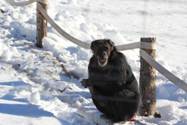 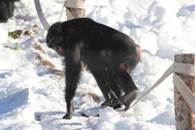 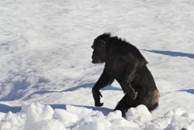
csnw chimpanzee snow
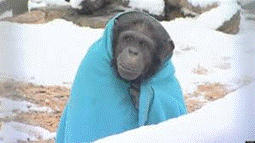
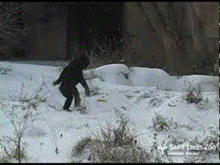
Wales
Ape and Monkey Sanctuary, U.K.
Saint Louis
Zoo, USA
See-through
curtains made from heavy-duty plastic strips can be hung
inside the night houses to keep the animals warm.
Management must take into consideration the type of
enclosure, the animals’ behavior and characteristics,
the materials used, if it would prevent the animals from
exiting or entering the enclosure, etc.
Suggestions:
The method used by the Chester Zoo, England is simple. Strips
of thick, clear ARCO PVC is cut to the length of the
slide and the holes are drilled in the PVC. A
strong, thick metal plate, which has the same amount of
holes drilled in it, is lined up and bolted onto the
wall. This makes it a lot easier to take off and
replace the broken or torn PVC strips.
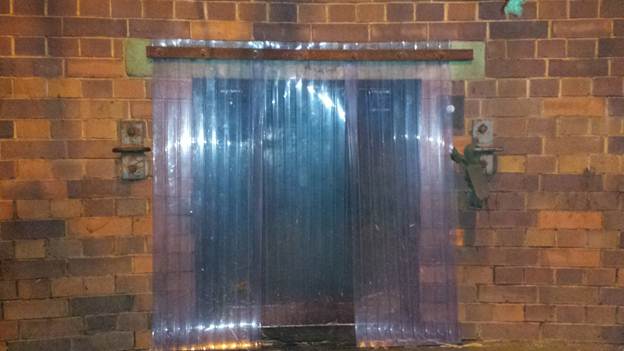
I
would like to thank the Hangzhou Zoo’s directors and
staff, as well as the
Chinese Association of Zoological Gardens, for
inviting me back and continuing to improve their
animals’ welfare.
I
would also like to thank Animals Asia Foundation for
funding and organizing this trip and establishing such a
wonderful, working relationship between the Jane Goodall
Institute, the Phoenix Zoo and the Hangzhou Zoo.
Hilda
Tresz
Behavioral
Enrichment & International Animal Welfare
Coordinator
Mentor,
The Jane Goodall Institute
Phoenix
Zoo | Arizona Center for Nature Conservation
455
N. Galvin Parkway | Phoenix, AZ 85008
p
602.286.3800
x 7120 | d
602.286.3820
htresz@phoenixzoo.org
|
phoenixzoo.org
|







